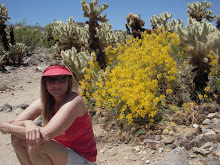 There are many versions of the story of how the Lost Horse Mine got its name. In one, Johnny Lang, while looking for his horse, sat on a rock to dislodge a stone from his shoe. He looked down and saw the yellow gleam of gold. Just then a gang of cattle rustlers--the infamous McHaney Brothers among them--discovered Lang on their turf and threatened him off.
There are many versions of the story of how the Lost Horse Mine got its name. In one, Johnny Lang, while looking for his horse, sat on a rock to dislodge a stone from his shoe. He looked down and saw the yellow gleam of gold. Just then a gang of cattle rustlers--the infamous McHaney Brothers among them--discovered Lang on their turf and threatened him off.Another version holds that Lang found his straying horse, which was later taken away at gunpoint. After Lang walked back to camp, he was further encouraged by the gang to move on and look for gold "in them thar hills." He discovered the Lost Horse strike and named the mine after his long-gone companion.
The likeliest version, which Lang himself recounted to Bill Keys, holds that the miner stopped by the McHaney's camp near Keys' Desert Queen Ranch to find that the gang had "confiscated" his missing horse. The cowboy gang directed Lang to "Dutch Frank" Diebold's camp where Diebold revealed that he had discovered a large gold strike, but had been unable to claim it because of interference from the McHaneys. Lang purchased the claim rights from Diebold for $1,000 dollars and took on partners with enough resources to mine the site. Eventually, Lang's partners sold off their shares to the local Ryan brothers.
Amalgam--a mixture of quicksilver and gold from which pure gold is later separated--was commonly used to mine the raw ore. Suspicions were aroused when the Lost Horse processing plant's night shift operations, which Lang supervised, produced significantly less amalgam than the day shift. After setting up a sting, the Ryans confronted Lang with a choice: sell his stake or face jail. Lang sold his portion for $12,000 dollars. Soon after, the gold vein was diverted because of an earthquake fault in its path. The mine went dry.
The aging prospector moved into a deserted cabin in a canyon near Hidden Valley, a part of Joshua Tree National Park where cattle rustlers were known to stash their booty. (The canyon was later named Johnny Lang Canyon as the prospector had worked a smaller claim there). Johnny moved into Keys' Desert Queen Ranch for a time. The arrangement was never comfortable because of Johnny's reputation as a thief.
When the Lost Horse Mine was finally abandoned, Lang returned to his former haunting grounds, taking up residence in an old shack that had served as a kitchen.Lang began selling large amounts of gold to Keys, too great a quantity to have come from his small mine in Johnny Lang Canyon. Keys and others believed that Johnny was secretly refining the amalgams he had skimmed and buried in earlier years.
To sustain himself during this time, Lang shot and ate livestock belonging to a local cattleman, C. O. Barker. When his health declined and his eyesight weakened, Lang turned to his burros.
After Bill Keys found Johnny Lang's body, burial was delayed until the cause of death could be determined. According to eyewitnesses, Lang's remains were left intact by coyotes and rodents, most likely because he was so lean. A month later, the coroner ruled that Johnny Lang had died of natural causes. The authorities instructed Keys to bury his body where it lay.
Unfortunately, Johnny Lang was not to rest in peace. In 1983, the old miner's grave was dug up in the middle of the night when raiders removed pieces of his remains, including his skull.
"Several mysteries still surround Johnny Lang," says Ranger Lentz, "such as what he had on him when he died, who dug him up, and why. Most likely," she says, "the perpetrators were looking for gold. Digging for anything is forbidden in the national park, which prohibits gold-seekers from further excavations. In the early 1990s, however, heavy rains caused several of the park's mine shafts to cave in. A lot of people hoped that Lang's treasure would be unearthed. It was never found."
Speculation still runs high that the gold Johnny Lang skimmed from the Lost Horse Mine is buried somewhere in Joshua Tree National Park, possibly in the Lost Horse area.
The question is... where?
Visit Johnny Lang's grave, the Lost Horse Mine, and Desert Queen Ranch in Joshua Tree National Park. For more information, stop at the JTNP Visitors Center on Utah Trail in Twentynine Palms.

No comments:
Post a Comment